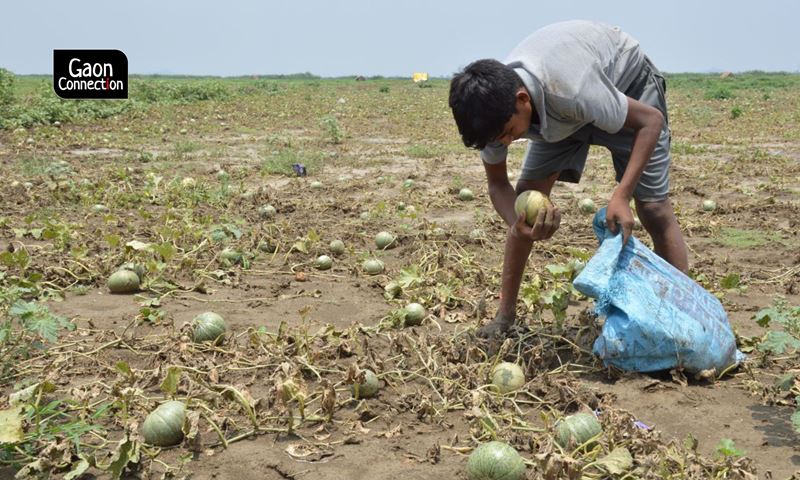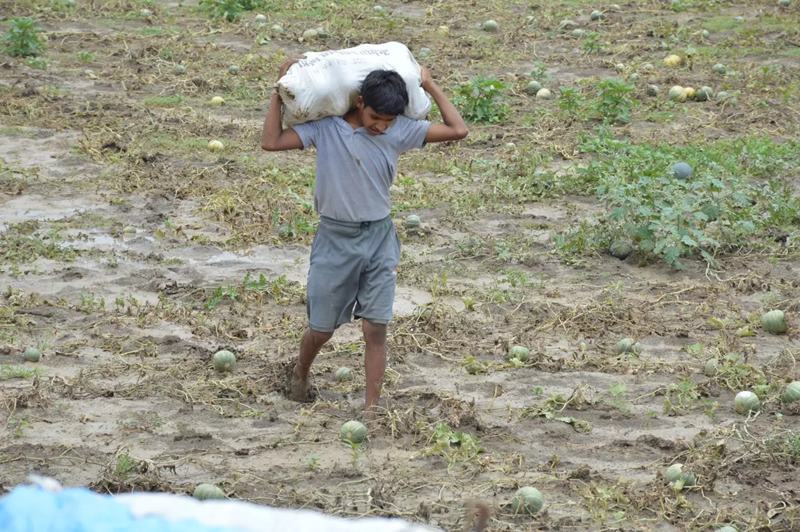As the Sarayu rises, hopes of sand farmers in Purvanchal drown
Every summer, lakhs of farmers raise gourds, cucumbers and watermelons on the sandy banks of rivers. However, last month, many rivers rose following unseasonal rains due to cyclones Tauktae and Yaas, drowning the crops.


The cyclones might have passed without too much of a human toll, but have left behind extensive destruction in their wake. Photo: Sachin Tulsa Tripathi
Mau, Uttar Pradesh
Come summer, and hundreds of hectares of riverbanks in Purvanchal region turn temporary farms as ‘sand’ farmers raise gourds such as parwal and tori, and cucumber and watermelon. The farmers bank on the sand and alluvium along river banks to nourish the crop. However, this year, the crop has been flooded, following intense rains after cyclones Tauktae and Yaas.
The water level of the Sarayu river, which flows through the northern part of Mau district, about 300 kilometres from state capital Lucknow, saw a significant rise last month due to multiple showers. This inflicted losses on sand farmers. The cyclones might have passed without too much of a human toll, but have left behind extensive destruction in their wake.
Every year, the Sarayu’s water level drops dramatically between February and April, causing the river to recede and leave a massive volume of sand on its banks. When the river recedes, a few people farm on the sandy soil, much like their counterparts do on other river banks throughout the country. Because this land does not belong to anyone, they do not receive any compensation for crop losses. This farming is done solely at the risk of the farmers.
Hope and despair on the Sarayu’s banks
On June 1, torrential rains lashed many districts in Uttar Pradesh, including Mau, Barabanki and Unnao. The water level in several rivers, most notably the Sarayu (Ghaghara), is expected to further rise in the next few days.

“This year, the extra sand deposited by the river created some additional dry land for us to farm on. We planted more vegetables and were waiting to reap the rewards. Already, we were producing vegetables worth two thousand rupees a day. But, the water levels have drowned our crops,” 40-year-old Basanti Devi of Mau told Gaon Connection.
Also Read: In a first, Muzaffarpur’s shahi litchi travels over 7500 kms to the United Kingdom
Devi lives in Dohrighat town, 40 kilometres from Mau district headquarters. On the banks of the Sarayu, she raises cucumbers, nainwa (sponge gourd), bitter gourd, watermelon and muskmelon. “We had not even managed to recover our costs yet when the flooding happened,” Basanti Devi teared up.
This year, the water level in the river began to rise in the second fortnight of May due to the cyclone. It had significantly increased by the beginning of June. Hundreds of hectares of vegetables planted by sand farmers in Mau district, from Dohrighat to Surajpur, were flooded.
“Every year, after June 15, the water level of the Ghaghara rises. However, heavy rains during the storm [Tauktae] destroyed our vegetable farms, and what remained of the crop drowned when the Sarayu’s water level rose,” 45-year-old Chirkut Sahni, a farmer from Dohrighat, told Gaon Connection.
“I had sown on one acre [0.40 hectares] of land, and was expecting a harvest worth one lakh rupees. Now, earning even a rupee looks difficult,” Sahni rued.

Also Read: Explained: How Yaas and Tauktae cyclones delayed the onset of monsoon
However, officials hope the water level will recede soon. “Purvanchal has also felt the effects of Yass and Tauktae. The river’s water level has risen dramatically due to heavy rainfall, but it is possible that it will decrease after a few days,” Virendra Paswan, an engineer in Mau’s Irrigation department, told Gaon Connection.
“It is raining in different states due to Western Disturbances. But the monsoon has not yet arrived in these parts; this is pre-monsoon rain. This weather could persist for a few more days,” N Chattopadhyay, director of Agromet, the agricultural meteorological department, in Pune told Gaon Connection.
Also Read: Cyclone Amphan’s anniversary of despair
The rain came as a double blow to farmers such as Sahni, who were already suffering the effect of a lockdown. “We cannot sell our produce in the limited time allowed by the state government. And now, the storm has destroyed our hopes,” he added.

Double blow to farmers
The rise in river levels has affected farmers in Madhya Pradesh too. Around 300 farmers from 10 villages who cultivated within a one-kilometre radius of Bakia Dam in Madhya Pradesh’s Satna region saw their melon crop destroyed. Cyclone Tauktae also resulted in rain in states such as Gujarat, Maharashtra and Rajasthan.
“We planted melon in four-five acres [1.6-2 hectares]. This used to fetch us up to three lakh rupees. However, business has been hurt by the Corona lockdown, and now the rain has ruined half the crop,” said Kulapati Singh, a 35-year-old farmer from Bakia Bailo village in Rampur Baghelan block of Satna district.
According to Kulapati, summer farming is the primary source of income for hundreds of farmers like him. He purchased a tractor worth Rs eight lakh last year, payable in instalments of Rs 75,000 a month. He was planning to sell the muskmelon and repay the loan, but that is not possible anymore.
According to a World Bank estimate, floods inflict property losses of Rs 5,000 crore (Rs 50 billion) and crop losses of Rs 1.68 crore (Rs 16.8 million) each year in the country.
Read the original story here.

